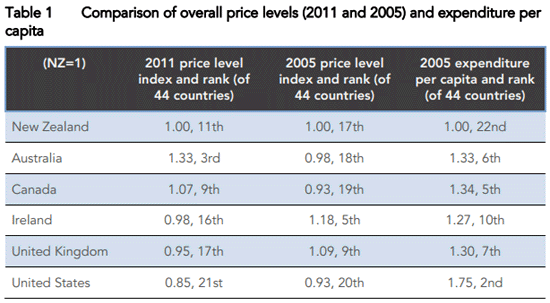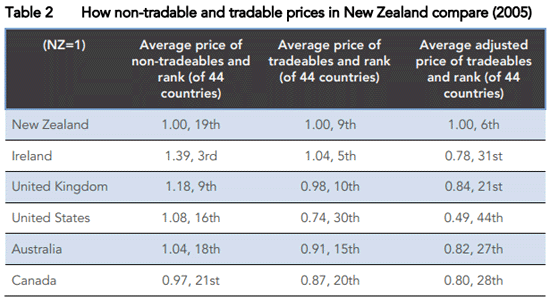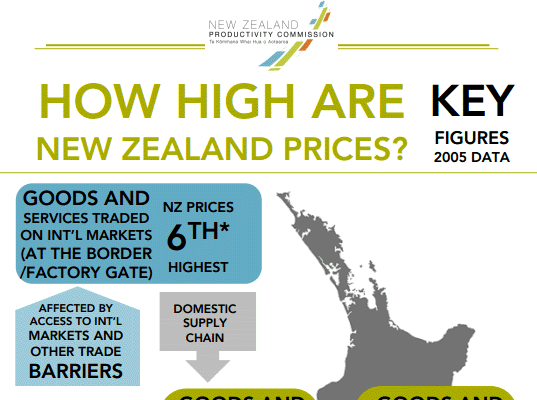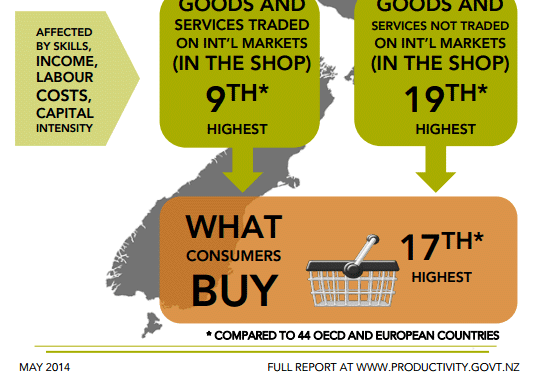
Content supplied by the Productivity Commission
The New Zealand Productivity Commission commissioned Professor Norman Gemmell, the Victoria University of Wellington Chair in Public Finance, to compare consumer prices in New Zealand with those overseas and to explain any differences identified.
It is impossible to say whether relative consumer prices are “too high” without also understanding what is driving these prices, as they may, for example, reflect intrinsic costs of production in New Zealand.
However, they may also reflect problems with our markets, such as a lack of competition in key areas or reduced access to international markets.
Using World Bank data, Professor Gemmell shows that prices are relatively high in New Zealand compared to other countries.
This is true for goods and services which face no direct foreign competition (non-tradables, e.g. rail freight transport) and for those that are traded internationally or in competition with foreign goods (tradables, e.g. electronics).
The project highlights the impact of New Zealand’s moderately low share of skilled workers and a small population on non-tradable prices.
It also shows that access to international markets (including transport costs) and the domestic supply chain costs of getting tradables from the New Zealand border or factory gate to the final consumer also contribute to higher prices of tradables.
Indeed, New Zealand’s price of tradables “at the border” – which exclude domestic supply chain costs – was the sixth highest in 2005 behind Iceland, Norway, Japan, Cyprus and Malta. Because these countries are also, to varying extents, isolated island economies, access to international markets is a likely key contributing factor to high tradable prices.
Why do prices differ across countries?
The research explains differences in non-tradables price across countries as due to differences in factor endowments (capital, labour, etc.), skills and population size – all of which potentially affect the supply of, and demand for, non-tradables in each country.
For products that are freely tradable on international markets, the key question is whether the law of one price holds.
Namely, are prices for the same tradable product the same in different countries when converted to a common currency?
If not, what trade impediments, exchange rate “misalignments” or other factors might explain the differences observed?
These differences could reflect tariff and non-tariff barriers, transport and other market access costs, and so on. Tradables also require some non-tradables to “deliver” them from the border or factory gate to the consumer.
This includes domestic transport costs, warehousing, wholesale and retail trade costs and indirect taxes.
As a result, the prices that consumers pay for tradables are also affected by these non-tradable input costs.
The research includes the effect of non-tradables prices on tradables prices. The research uses ICP data on prices of around 150 “basic heading” items in 2005 to create aggregate tradable and non-tradable expenditure/price categories.
The analysis works mainly with a sample of 44 OECD-Eurostat countries for which all necessary data is available.
How do prices in New Zealand compare?
Overall price levels in 2011 and 2005
World Bank data on the overall price levels in New Zealand and a number of other countries are shown in Table 1. The figures are based on the World Bank’s International Comparison Programme (ICP) data for 2005 and 2011. These data are collected by the ICP with the aim of measuring prices and expenditures for a basket of comparable goods and service expenditures across countries. The latest year for which these World Bank data are available is 2011. The most recent detailed data available on specific prices are for 2005, which were primarily used in the analysis.
In 2011, the overall price level in New Zealand was below that of Australia but above that of the United Kingdom.
Table 1 also compares these price levels to OECD data on expenditure per capita. This shows that, when judged against average expenditure, the price level in New Zealand appears relatively high.
Prices may, for instance, be 9% higher in the United Kingdom than in New Zealand in 2005, but their expenditure per capita was 30% greater than ours.
New Zealand appears to have relatively high prices given our income levels.

What is cheap or expensive in New Zealand?
New Zealand’s overall consumer price level can be broken down into specific prices using the 2005 World Bank data. These data show that, relative to other OECD countries, some broad features of consumer price levels in New Zealand stand out.
Goods and services associated with investment in general appear to be relatively expensive.
This is especially true for property, construction and utilities (water, gas and electricity).
Passenger transport (excluding private motor vehicles) and alcohol and tobacco prices are also relatively expensive compared to other countries.
In contrast, prices for key exportable products from New Zealand are relatively cheap – especially beef, veal, lamb, fish and dairy products.
Services that are largely government provided – such as education, health and social protection – are also relatively inexpensive.
This reflects New Zealand’s relatively low wage levels, as wage costs are an important determinant of measured (non-market) prices in these sectors.
Prices for non-tradable and tradable prices
It is possible to break down New Zealand’s overall price level into the prices for non-tradable and tradable goods and services (Table 2).
Relatively high-income OECD countries feature prominently among the countries with the highest prices for non-tradables.
In 2005, New Zealand had the 19th highest price level for these goods and services among the 44 OECD-Eurostat countries included in the research.

The prices for tradables display a similar pattern, but there are some variations.
Of the 44 OECD-Eurostat countries in the World Bank data, New Zealand had the 9th highest average tradables price. Table 2 also removes the effect of domestic supply chain prices from the price of tradables to give a rough estimate of prices for tradables at the border.
On this measure, New Zealand had the 6th highest price of adjusted) tradables prices in the World Bank data set.
Thus while New Zealand ranks relatively highly among international non-tradable prices it has an especially high relative international price of tradables products arriving at New Zealand’s border.
Explaining New Zealand’s prices
New Zealand’s relative low capital intensity and trade deficits would lead us to expect lower non-tradable prices. However, our lower than average skilled labour and population would lead us to expect higher non-tradable prices.
The fact that New Zealand has relatively high prices, therefore, indicates the dominant effect of New Zealand’s lower than average values for skilled labour and population.
These non-tradables prices then have a feedback effect onto our tradables prices.
The impact of non-tradable prices on the consumer price of tradables is an important reason why consumer prices differ across countries.
New Zealand’s price of non-tradables accounts for around 35 to 40 per cent of the domestic price of tradables for consumers, compared to border or factor gate prices. This is quite similar to other OECD countries on average and is only a part of the explanation of New Zealand’s relatively high tradables prices.
Although the drivers of tradable prices at the border are not explicitly modeled, relatively high prices in New Zealand’s case could reflect greater trade impediments and/or higher indirect taxes.
It is likely that the former dominates the latter, since general indirect taxes in New Zealand are not unusually high by OECD standards.
Indeed, the price of tradables at the border was the sixth highest in New Zealand behind Iceland, Norway, Japan, Cyprus and Malta, all of which are, to varying extents, isolated island economies.
This work has contributed to the inquiry Boosting productivity in the services sector.


--------------------------------------------------------
This article is was released today as part of the Commission's Working Paper 08/2014
8 Comments
Cheapest place I've ever bought groceries - Lima.
Probably about 30% of the cost of New World.
The farmers markets in Malawi are way cheaper than the farmers markets here!
Not mentioned in this report is the high price of our land. Maybe the effect is small, but I would think that if a company has to invest 4 times the capital (compared to the US) to set up shop, that's got to have some impact on prices.
Thanks to inflationism, the supply of money rises faster than population and productivity. All that extra money needs to be parked somewhere...
Why does a VW Golf cost $32500 (excl on-road costs) here, but AUD22990/NZD24805.87 (drive-away) in Victoria? What a rip.
Norway is an isolated island economy to the "varying extent" that you can drive by car from Oslo to Berlin.
More Seriously, Is there any estimates as to the amount the exclusive supply licences and authorised dealer areas add to the amount. Because New Zealand is generally a subset of Australia which is a subset of Asia Pacific, and each level wants their cut. It strikes me you could compare products bought through local agents with products direct imported as a pretty fair measure of the amount.
You can also get a ferry to the UK, or travel by train to Vietnam. They think just because is has a small population and a bit of coastline that it's isolated? It's part of the EEA FFS.
It would seem nearly all the relative price changes between 2005 and 2011 are explained by changes in exchange rates. The AUD appreciated by 20% against the NZD in the six years, and their relative prices went up even more- by 36%. Similarly the GBP depreciated against the NZD by 30%; while British prices declined by 15% in real terms.
That says to me that prices in local terms are relatively inelastic to movements in the exchange rate. The benefits of an appreciation go mainly to the offshore manufacturers, and perhaps their local agents, and far less to the local consumers. (The real costs are to local competing manufacturers and suppliers). The converse is true. When a currency depreciates, as the GBP has, the offshore suppliers and their local agents suffer- consumers far less so.
That all supports from a national point of view, taking part in the ongoing currency wars, otherwise with a very high NZD, the clear beneficiaries are our overseas suppliers, who do not need to drop their prices, and so by and large, haven't.
No surprises at all, although the Reserve Bank and Treasury often act as though this is not true, and seem to believe that a high exchange rate feeds through quickly to lower prices.
We welcome your comments below. If you are not already registered, please register to comment
Remember we welcome robust, respectful and insightful debate. We don't welcome abusive or defamatory comments and will de-register those repeatedly making such comments. Our current comment policy is here.